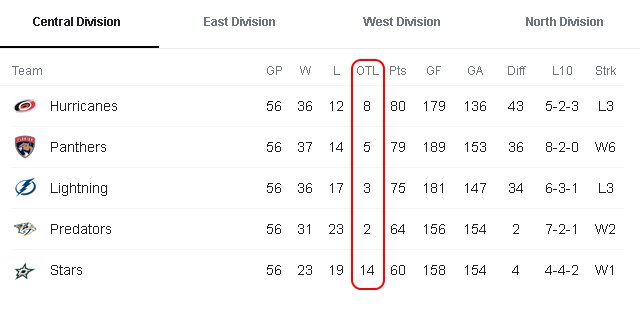Hockey is a sport that comes with a lot of abbreviations, and learning all of them can get a little confusing. OTL for example, what does OTL stand for in hockey?
In hockey, OTL stands for overtime loss. If a game is tied following the end of regulation time, the game will go into overtime. The team that loses the game has an overtime loss (OTL) added to their record and earns one point.
Table of Contents
Why are overtime losses counted separately?

You may notice when looking at the standings that there are three different columns for a teams record. Win, loss and OTL. But why are overtime losses counted separately from normal loses?
Overtime losses are counted separately because the team that loses in overtime is awarded one point in the standings as opposed to a regulation loss in which the team receives zero points.
This is why games that go to overtime are typically refereed to as three point games, in overtime the winning team gets two points and the losing team gets one point.
Hockey overtime explained
In hockey, overtime is extra time added to the game to help decided a winner should a game end in a tie at the end of regulation time.
Currently in the regular season, overtime is a 5-minute period that is played with just three players from each team on the ice (3 on 3).
If the game is still tied at the end of the 5-minute period, the game will be decided in a shootout, where players from each team take turns shooting on the opposing teams’ goalie.
Overtime in the playoffs
During playoff games, overtime periods are full length 20 minute periods. Unlike the regular season, there is no shootout to decide the game.
Games will go to continuous 20 minute overtime periods until a winner is decided.
History of the OTL
If you’ve ever watched hockey, you’d notice that a good portion of games are tied at the end of regulation.
In fact, during the 2020-21 NHL season, there were 896 games played in total; 196 of those games ended tied in regulation time and were decided in overtime.
Let’s face it no one wants to watch a game end in a tie, they are hard to sell and everyone prefers a winner be declared.
To solve this issue, back in the early 1983 the NHL decided the league would benefit from adding an extra period called overtime, should the game we tied after regulation.
However, the losing team in overtime didn’t always receive a point, it wasn’t until the 1999–2000 season that the NHL decided to introduce “loser points” this was also the birth of the “OTL” column in the standings.
What does SOL mean?
If there is no winner decided during the overtime period, teams will move to a shootout. When a team loses in the shootout, it’s marked as “SOL”.
SOL refers to a shootout loss. Much like an overtime loss, the team that loses in a shootout is still awarded one point.


